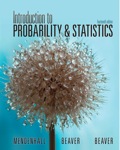
Concept explainers
(a)
To calculate the probability that more than six consumers say they have become conservative spenders.
(a)
Answer to Problem 5.82SE
The probabilities that more than six consumers say they have become conservative spenders is
Explanation of Solution
Since we are interested in the number of successes among a fixed number of independent trials with a constant probability of success, we can use the Binomial distribution.
The binomial probability is defined as,
Where
Now, the probability that more than six consumers say they have become conservative spenders implies,
Where,
Which implies,
Thus, we have,
And now,
(b)
To calculate the probability that fewer than five of those sampled have become conservative spenders.
(b)
Answer to Problem 5.82SE
The probabilities that fewer than five of those sampled have become conservative spendersis
Explanation of Solution
Since we are interested in the number of successes among a fixed number of independent trials with a constant probability of success, we can use the Binomial distribution.
The binomial probability is defined as,
Where
Now, the probability that fewer than five of those sampled have become conservative spenders implies,
Which implies,
Thus, we have,
(c)
To calculate the probability that exactly nine of those sampled have become conservative spenders.
(c)
Answer to Problem 5.82SE
The probabilities that exactly nine of thosesampled have become conservative spenders is
Explanation of Solution
Since we are interested in the number of successes among a fixed number of independent trials with a constant probability of success, we can use the Binomial distribution.
The binomial probability is defined as,
Where
Now, the probability that exactly nine of thosesampled have become conservative spenders implies,
Want to see more full solutions like this?
Chapter 5 Solutions
EBK INTRODUCTION TO PROBABILITY AND STA
- Flexible Work Hours In a recent survey, people were asked whether they would prefer to work flexible hours----even when it meant slower career advancement----so they could spend more time with their families. The figure shows the results of the survey. What is the probability that three people chosen at random would prefer flexible work hours?arrow_forwardShow the sample space of the experiment: toss a fair coin three times.arrow_forward

 Algebra and Trigonometry (MindTap Course List)AlgebraISBN:9781305071742Author:James Stewart, Lothar Redlin, Saleem WatsonPublisher:Cengage Learning
Algebra and Trigonometry (MindTap Course List)AlgebraISBN:9781305071742Author:James Stewart, Lothar Redlin, Saleem WatsonPublisher:Cengage Learning College AlgebraAlgebraISBN:9781305115545Author:James Stewart, Lothar Redlin, Saleem WatsonPublisher:Cengage Learning
College AlgebraAlgebraISBN:9781305115545Author:James Stewart, Lothar Redlin, Saleem WatsonPublisher:Cengage Learning- Algebra & Trigonometry with Analytic GeometryAlgebraISBN:9781133382119Author:SwokowskiPublisher:Cengage
 College Algebra (MindTap Course List)AlgebraISBN:9781305652231Author:R. David Gustafson, Jeff HughesPublisher:Cengage Learning
College Algebra (MindTap Course List)AlgebraISBN:9781305652231Author:R. David Gustafson, Jeff HughesPublisher:Cengage Learning




